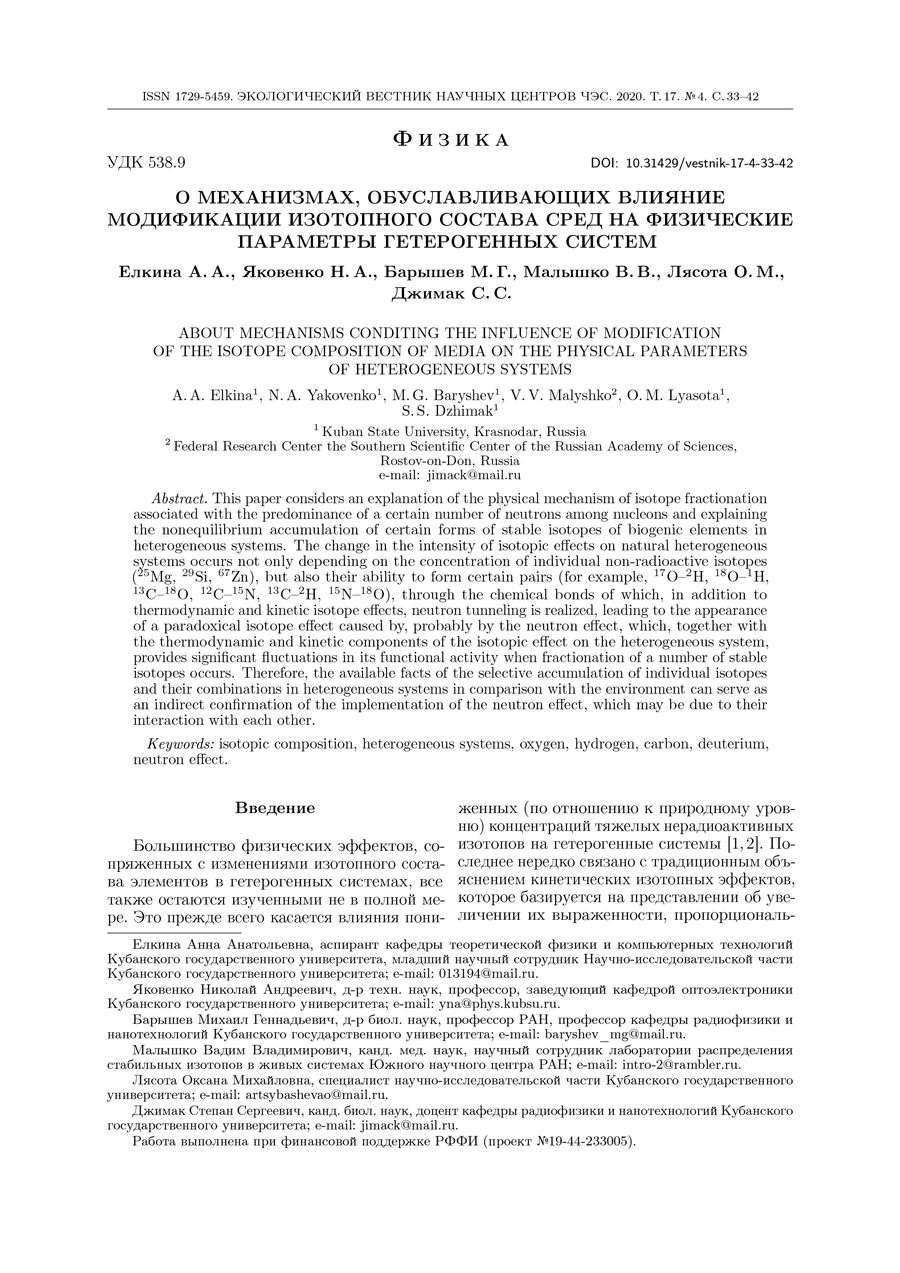About mechanisms conditing the influence of modification of the isotope composition of media on the physical parameters of heterogeneous systems
UDC
538.9DOI:
https://doi.org/10.31429/vestnik-17-4-33-42Abstract
This paper considers an explanation of the physical mechanism of isotope fractionation associated with the predominance of a certain number of neutrons among nucleons and explaining the nonequilibrium accumulation of certain forms of stable isotopes of biogenic elements in heterogeneous systems. The change in the intensity of isotopic effects on natural heterogeneous systems occurs not only depending on the concentration of individual non-radioactive isotopes (25Mg, 29Si, 67Zn), but also their ability to form certain pairs (for example, 17O–2H, 18O–1H, 13C–18O, 12C–15N, 13C–2H, 15N–18O), through the chemical bonds of which, in addition to thermodynamic and kinetic isotope effects, neutron tunneling is realized, leading to the appearance of a paradoxical isotope effect caused by, probably by the neutron effect, which, together with the thermodynamic and kinetic components of the isotopic effect on the heterogeneous system, provides significant fluctuations in its functional activity when fractionation of a number of stable isotopes occurs. Therefore, the available facts of the selective accumulation of individual isotopes and their combinations in heterogeneous systems in comparison with the environment can serve as an indirect confirmation of the implementation of the neutron effect, which may be due to their interaction with each other.
Keywords:
isotopic composition, heterogeneous systems, oxygen, hydrogen, carbon, deuterium, neutron effectAcknowledgement
References
- Yaglova N.V., Obernikhin S.S., Yaglov V.V., Nazimova S.V. Time-dependent effect of deuterium depletion on tumor growth and metastasis. Russian Open Medical Journal, 2020, vol. 9, iss. 2, p. 210. DOI: 10.15275/rusomj.2020.0210
- Syroeshkin A., Levitskaya O., Uspenskaya E., Pleteneva T., Makarova M., Romaykina D., Ermakova D. Deuterium depleted water as an adjuvant in treatment of cancer. Systematic Reviews in Pharmacy, 2019, vol. 10, iss. 1, pp. S26 S31.
- Basov A., Fedulova L., Baryshev M., Dzhimak S. Deuterium-depleted water influence on the isotope 2H/1H regulation in body and individual adaptation. Nutrients, 2019, vol. 11, iss. 8, p. 1903. DOI:10.3390/nu11081903
- Basov A., Drobotenko M., Svidlov A., Gerasimenko E., Malyshko V., Elkina A., Baryshev M., Dzhimak S. Inequality in the frequency of the open states occurrence depends on single 2H/1H replacement in DNA. Molecules, 2020, vol. 25, iss. 16, p. 3753. DOI: 10.3390/molecules25163753
- Basov A.A., Fedulova L.V., Vasilevskaya E.R., Dzhimak S. Possible mechanisms of biological effects observed in living systems during 2H/1H isotope fractionation and deuterium interactions with other biogenic isotopes. Molecules, 2019, vol. 24, iss. 22, p. 4101. DOI: 10.3390/ molecules2422410110.3390/molecules24224101
- Elkina A.A., Tumaev E.N., Basov A.A., Moiseev A.V., Malyshko V.V., Barysheva E.V., Churkina A.V., Dzhimak S.S. Mekhanizmy vzaimodeystviya stabil'nykh izotopov s biologicheskimi ob"ektami s uchetom neskompensirovannogo neytrona v khimicheskikh svyazyakh [Mechanisms of modern modeling of biological isotopes of objects with a degree of non-compensated neutrality]. Biofizika [Biophysics], 2020, vol. 65, no. 5, pp. 1034 1040. DOI: 10.31857/S0006302920050221 (In Russian)
- Xie X., Zubarev R.A. Isotopic Resonance Hypothesis: Experimental Verification by \textit{Escherichia coli Growth Measurements. Scientific reports, 2015, vol. 5, p. 9215. DOI: 10.1038/srep09215
- Li X., Snyder M P. Yeast longevity promoted by reversing aging-associated decline in heavy isotope content. NPJ Aging and Mechanisms of Disease, 2016, vol. 2, p. 16004. DOI: 10.1038/npjamd.2016.4
- Buchachenko A. L., Kouznetsov D. A. Efficiency of ATP synthase as a molecular machine. Biophysics, 2008, vol. 53, iss. 3, pp. 219 222.
- Andriukonis E., Gorokhova E. Kinetic 15N-isotope effects on algal growth. Scientific reports, 2017, vol. 7, p. 44181. DOI: 10.1038/srep44181
- Letuta U.G., Tikhonova T.A. Magnetic fields and magnetic isotope 25Mg effects on biofilms formation by bacteria E. coli. Doklady Biochemistry and Biophysics, 2019, vol. 484, iss. 1, pp. 85 87.
- Lysenko O.B., Demikhov Y.N., Skul'skii N.A., Sobotovich E.V. The role of a magnetic effect in uranium isotope fractionation. Russian Journal of Physical Chemistry B, 2014, vol. 8, iss. 6, pp. 870 873.
- Xin Y.-B., Hu Q., Niu D.-H., Zheng X.-H., Shi H.-L., Wang M., Xiao Z.-S., Huang A.-P., Zhang Z.-B. Research progress of hydrogen tunneling in two-dimensional materials. Acta Physica Sinica, 2017, vol. 66, iss. 5, p. 056601.
- Drechsel-Grau C., Marx D. Exceptional isotopic-substitution effect: breakdown of collective proton tunneling in hexagonal ice due to partial deuteration. Angewandte Chemie International Edition, 2014, vol. 53, pp. 10937 40. DOI: 10.1002/anie.201405989
- Karlson A.M.L., Reutgard M., Garbaras A., Gorokhova E. Isotopic niche reflects stress-induced variability in physiological status. Royal Society Open Science, 2018, vol. 5, iss. 2, p. 171398.
Downloads
Submitted
Published
How to Cite
Copyright (c) 2020 Elkina A.A., Yakovenko N.A., Baryshev M.G., Malyshko V.V., Lyasota O.M., Dzhimak S.S.

This work is licensed under a Creative Commons Attribution 4.0 International License.




